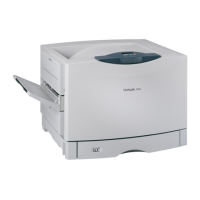PJL
3-89
Note: If PostScript emulation is used to create the file on the device, it may
automatically attach a
.data extension to the fname. See “Filename
Extensions” on page 6-10 for more information. For example, if
"myfile" is
downloaded to flash through PostScript emulation, the
fname on the PJL
commands is
"myfile.data".
LOPENFILE Command
Use this command to open a file on a storage device.
Syntax:
@PJL LOPENFILE DEVICE = filedevice FILENAME = "fname"
ACCESS =
accesstype[<CR>]<LF>
LCLOSEFILE Command
Use this command to close a file on a storage device. The command is ignored if the
file doesn’t exist on the device or if the file is not open.
Syntax:
@PJL LCLOSEFILE DEVICE = filedevice FILENAME = "fname"[<CR>]<LF>
location
START = location The location in the file to begin writing or reading. Use an
integer that represents an offset in bytes from the beginning
of the file.
Optional for both LREADFILE and LWRITEFILE commands.
If omitted on an LREADFILE command,
location of 0
(beginning of the file) is assumed. If omitted on an
LWRITEFILE command with an
accesstype of RW,
location of 0 is also assumed.
If a START location is provided but it is greater than the file
size, the LREADFILE command response will contain no file
data. Similarly, an LWRITEFILE command with an
accesstype of RW functions like an LWRITEFILE
command with an
accesstype of AP.
Table 3-22: Variables for Flash and Disk File and Password Commands (Continued)
Parameter Syntax Description

